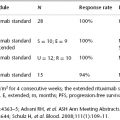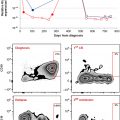Primary Cutaneous Lymphoma
Mayo Clinic, Rochester, MN, USA
Introduction
The cutaneous T-cell disorders are a complex heterogeneous group of lymphoproliferative disorders that represent the second most common extranodal site for non-Hodgkin’s lymphoma. Management requires a team that includes dermatology, pathology, nurses, hematology and oncology physicians, social workers, and others. A definitive diagnosis, assessment of risk stratification, and an understanding of the multiple therapeutic interventions available aid in providing improved outcomes for patients.
1. What is the incidence of cutaneous T-cell lymphoma?
The most common cutaneous T-cell lymphomas (CTCLs) are mycosis fungoides (MF) and Sézary syndrome (SS). About 50% of cases are MF, and the second most common subtype is SS. SS more characteristically arises without a previous history of MF. If MF evolves into SS, then the diagnosis should be erythrodermic mycosis fungoides. The estimated annual incidence of these disorders in the Surveillance, Epidemiology, and End Results (SEER) database is 1 per 100,000. In a well-defined population of Rochester, Minnesota, it was 0.9 per 100,000 residents.
2. How do patients present?
The incidence increases with age, and the average age at diagnosis is 50 to 60 years, but the disorder can occur at any age, including childhood. The disorder is more likely to occur in black populations.
Patients may have a premalignant phase of several years to decades in duration with eczematous or dermatitis skin lesions before a diagnosis is firmly established. The median duration of a premalignant phase is 6 years. It is not uncommon for patients to present with a history of multiple skin biopsies. The spectrum of premalignant disorders includes large-plaque parapsoriasis, poikiloderma atropicans vasculare, follicular mucinosis, pityriasis lichenoides et varioliformis acuta (Mucha–Habermann disease), and other atypical infiltrates of the skin.
The classic malignant stages of CTCL are manifested in the skin and include patch-stage CTCL, plaque-stage CTCL, tumor-stage CTCL, and erythrodermic CTCL. Pruritis may or may not be a feature. Pigmentation may be altered. Lesions may be present for months to years before the plaque stage of CTCL develops. Plaque- and tumor-stage CTCL are sharply demarcated circular plaques that are infiltrated, elevated above the surrounding normal skin, erythematous, occasionally violaceous, and characteristically on the trunk and extremities. When patches overlap, a geographic pattern in appearance is produced. When plaques affect the face, the dermal thickening may progress to give the classic leonine facies. Infiltration of the skin of the palms and soles results in hyperkeratosis and fissuring. With disease progression, there is extracutaneous, nodal, and extranodal involvement. Tumor-stage lesions are a reflection of a more clinically aggressive course, occur at sites of previous plaque-stage involvement, and have a predilection for the body folds, including the groin, antecubital fossa, neck, axilla, and inframammary areas. At the time of the initial presentation, approximately 40% of patients have plaques on less than 10% of the body surface area, 30% have extensive plaques, 15% exhibit a tumor phase, and 10% have an erythrodermic phase.
SS is defined by the presence of Sézary cells in the peripheral blood with skin changes. Sézary cells are characterized by changes in individual nuclei, including irregularity, prominent indentations, and convolutions with a cerebriform appearance. The erythrodermic form of CTCL, SS, presents with exfoliative erythroderma, lymphadenopathy, and keratoderma or thickening of the skin of the palms and soles with cracks and fissures (palmoplantar hyperkeratosis). Significant pruritis, which is characteristic, leads to excoriations, exudation, and crusting. Nail dystrophy (onychodystrophy), ectropion (eversion of the eyelids, giving the appearance of a “pulled-down” appearance of the lower lids), and alopecia are usually present.
As MF and SS progress, extracutaneous disease involves lymph nodes, bone marrow, liver, and other organs.
3. What causes cutaneous T-cell lymphomas?
The cause of the majority of CTCLs is unknown. Two case–control studies have not supported environmental factors. Prolonged exposure to contact allergens such as plants, metals, cosmetics, medications, foods, and insect bites between MF patients and controls demonstrated no associations. In selected cases, however, patients with atopy, contact sensitivity, chronic dermatitis, and immunodeficiency may develop CTCL. CTCL has been documented after B-cell lymphoma, Hodgkin lymphoma, acquired immune deficiency syndrome, and posttransplant lymphomas.
4. How are cutaneous T-cell lymphomas classified?
Cutaneous lymphomas include CTCL and cutaneous B-cell lymphomas. Cutaneous lymphomas are distinguished on the basis of their clinical, histologic, immunologic, and molecular features. The World Health Organization–European Organization for Research and Treatment of Cancer (WHO–EORTC) classification for cutaneous lymphomas is outlined in Table 49.1.
Table 49.1 World Health Organization–European Organization for Research and Treatment of Cancer classification of primary cutaneous lymphomas (Source: Willemze R, et al. Blood. 2005;105:3768–85).
| Cutaneous T-cell and natural killer (NK)-cell lymphomas |
|---|
| Mycosis fungoides (MF) |
| MF, variants and subtypes |
| Folliculotropic MF |
| Pagetoid reticulosis |
| Granulomatous slack skin |
| Sézary syndrome |
| Adult T-cell leukemia or lymphoma |
| Primary cutaneous CD30+ lymphoproliferative disorders |
| Primary cutaneous anaplastic large-cell lymphoma |
| Lymphomatoid papulosis |
| Subcutaneous panniculitis-like T-cell lymphoma |
| Extranodal NK- and T-cell lymphoma, nasal type |
| Primary cutaneous peripheral T-cell lymphoma, unspecified |
| Primary cutaneous aggressive epidermotropic CD8+ T-cell lymphoma (provisional) |
| Cutaneous γ/δ T-cell lymphoma (provisional) |
| Primary cutaneous CD4+ small and medium-sized pleomorphic T-cell lymphoma (provisional) |
| Cutaneous B-cell lymphomas |
| Primary cutaneous marginal zone B-cell lymphoma |
| Primary cutaneous follicle center lymphoma |
| Primary cutaneous diffuse large B-cell lymphoma, let type |
| Primary cutaneous diffuse large B-cell lymphoma, other |
| Intravascular large B-cell lymphoma |
| Precursor hematologic neoplasm |
| CD4+/CD56+ hematodermic neoplasm (blastic NK-cell lymphoma) |
5. How are cutaneous T-cell lymphomas diagnosed?
The diagnosis of CTCL is established by tissue biopsy, usually a punch skin biopsy with specimens 4 to 6 mm deep for histology, immunohistochemistry, and molecular genetic studies. Classic histologic manifestations include abnormal lymphocyte morphology, a band-like superficial dermal infiltrate, epidermotropism, and Pautrier’s microabscesses. Significant variability exists in the expression of these pathologic characteristics.
The diagnosis is based on clinic-pathologic criteria. The diagnostic criteria for classic MF and SS are as follows. MF requires four points (histopathologic, molecular biological, and immunologic), two points for one basic criterion plus two additional criteria or one point for basic criteria and one additional criterion. The basic criteria are persistent and/or progressive patches or plaques with additional criteria of non-sun-exposed location, variation in size or shape, and poikiloderma. Histologic criteria (2 points for one basic plus one additional criterion) are as follows. The basic criterion is superficial lymphoid infiltrate, with additional criteria of epidermotropism without spongiosis and lymphoid atypia (cells with large cerebriform nuclei). Molecular biologic criteria (1 point) are clonal T-cell receptor (TCR) gene rearrangement. Clonal rearrangements of the TCR-beta gene have been documented in most patients. Immunopathologic criteria (1 point for ≥1 criteria) are <50% CD2+, CD3+, and/or CD5+ T-cells; less than 10% CD7+ cells; and erythrodermal or dermal discordance of CD2, Cd3, CD5, or CD7.
The tumor stage of MF and SS is characterized by dense dermal infiltration that often extends into the deep dermis and subcutis, becoming nonepidermotropic or less epidermotropic. A complete transformation to a large-cell variant that resembles diffuse large B-cell lymphoma or anaplastic lymphoma is typically seen in tumors.
The diagnostic criteria for SS are clonal rearrangement of the TCR (by Southern blot or polymerase chain reaction) and absolute Sézary count ≥1000 μl. If the Sézary count is not able to be used, then look for increased CD4+ or CD3+ T-cells with a CD4–CD8 ratio ≥10 or an abnormal immunophenotype as manifested by a CD4+-to-CD7− ratio ≥40% or a CD4+-to-CD26− ratio ≥30%.
6. What are the variants and subtypes of MF and SS?
The variants of MF include folliculotropic MF, which is a disorder of localized alopecia with mucin deposition in the hair follicle; pagetoid reticulosis, which is characterized by solitary slow-growing plaques (Woringer−Kolopp type) or disseminated patches on the hands and feet; and granulomatous slack skin, which is characterized by excessive redundant folds of the skin and plaques in the axilla and groin.
The differential diagnosis, variants, and subtypes of SS include different disorders. Adult T-cell leukemia or lymphoma is associated with the T-cell leukemia virus 1 (HTLV1). Primary cutaneous CD30+ lymphoproliferative disorders include anaplastic large cell lymphoma and lymphomatoid papulosis. Lymphomatoid papulosis is defined as a chronic, recurrent, erythematous, and self-healing papulonodular skin disease where the lesions spontaneously resolve in 3 to 12 weeks with an unpredictable duration of disease from months to 20 years. This disease may be associated with Hodgkin lymphoma, cutaneous anaplastic large-cell lymphoma, or mycosis fungoides.
It is essential to differentiate CTCL disorders from other T-cell lymphoproliferative disorders as defined by the WHO Classification of Tumours of Haematopoietic and Lymphoid Tissues.
7. What is the natural history of cutaneous T-cell lymphoma?







